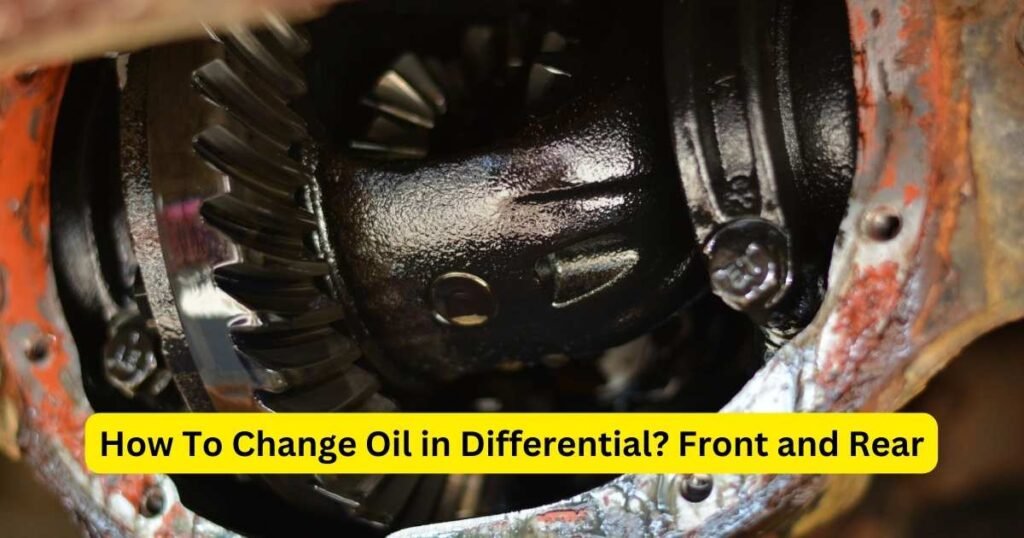The differential is an essential part of your car’s drivetrain. It helps distribute power between the wheels and makes turning corners smooth. Changing the differential fluid regularly is important to keep it working well.
Changing the differential fluid is key to maintaining the performance and longevity of this important component. Following this guide will teach you the steps needed to complete this task, whether you choose to do it yourself or prefer talking to a mechanic about it.
Main Key Takeaways:
- Regular fluid changes maintain differential performance and longevity.
- The process varies in time; it is quick for professionals and longer for DIY based on experience.
- Correct fluid type and safety steps are crucial for successful maintenance.
In this article:
What is Differential Fluid and Why it Matters?
The part of your vehicle positioned between the axles is known as the differential. It allows the axles to rotate at different speeds, which is especially important during turns. Inside the differential, gears work together to transfer power from the engine.
These gears are protected by a special fluid called differential fluid or gear oil, which prevents them from grinding against each other. This fluid is essential because, without it, the gears would wear out quickly due to friction.
Your vehicle’s manual will tell you when it’s time to change the differential fluid. Generally, it’s recommended to change it every 30,000 to 50,000 miles to keep your vehicle running smoothly.
Choosing the correct differential fluid involves considering two main factors: viscosity and the GL rating. Viscosity refers to how thick the fluid is. The owner’s manual can provide the right viscosity for your vehicle’s differential. The GL rating indicates how much protection the fluid offers against extreme pressures. Using the recommended type of fluid is essential to avoid damaging your differential.
If your vehicle has a limited-slip differential (LSD), which helps improve traction by controlling how much torque goes to each wheel during turns, you’ll need a special differential fluid. This fluid includes additives that allow the LSD to work properly. Make sure to check your owner’s manual to choose a fluid that has the proper additives for your LSD.
What are the Signs You Might Need a Differential Fluid Change?
Changing the differential fluid is important in keeping your car running smoothly. Sometimes, you might need to change the fluid sooner than expected. Here are a few signs to watch for:
If you hear whining or grinding noises from the back of your car, it could mean that the differential fluid is old or running low. This type of noise often comes from the gears in the differential when they’re not well-lubricated.
Another sign is difficulty during cornering. If the wheels are sticking or grabbing when you turn, this might be because the differential fluid needs to be replaced.
Finally, look for leaks around the differential area, which is located near the back of your car. Leaks can happen if the gasket or seal is worn out. Seeing fluid underneath your car in this area means it’s time to check and possibly replace the differential fluid.
If you notice any of these issues, it’s wise to take your car to a mechanic. They can check and replace the fluid if necessary, helping your car drive better and last longer.
We’ll learn how to change the oil in the front and rear differentials. Before changing the differential fluid, you must consider some essential things.
What are the safety considerations to learn while changing fluid?
You can do it safely when you need to work on your car and lift it. Here’s how to get started.
1. Find a flat area to park your car. This makes sure your vehicle stays steady while you work. Before you do anything else, remember to pull up the parking brake. This helps prevent the car from rolling.
2. Place chocks behind the wheels that will stay on the ground. Chocks are like small blocks that stop the wheels from moving. It’s important to use them so your car doesn’t start rolling when you lift it.
3. Now, you’re ready to lift the car. Use a jack to raise the car off the ground, but don’t go under the car yet. Once the car is lifted, put jack stands underneath it. These stands will hold the car up safely while you work. Make sure the jack can handle the weight of your vehicle. You should never get under a car if it’s only held up by a jack because it could fall and hurt you.
By following these steps, you can easily and safely lift your car and make your repairs without any worries.
What are the Necessary Tools and Materials you need?
Before you start replacing your differential fluid, gathering all the tools and materials you’ll need is important. First, get a drain pan where the old fluid can drip as you work. You’ll also need a set of socket wrenches. A torque wrench isn’t necessary, but it can help a lot.
Check your car’s owner’s manual to determine the required type and amount of differential fluid. It’s a good idea to have some rags handy for cleaning up spills. If you want to make filling the fluid back in more accessible, consider getting a fluid pump.
If your differential cover uses a gasket, you might need a new one, depending on your vehicle. If there isn’t a gasket, you should get some RTV sealant to prevent leaks after you’ve finished the job. This will help ensure everything is sealed up tight and working smoothly.
How To Change Oil in Differential? Step By Step Process
Before changing your car’s differential fluid, ensure you have everything you need. Gather your tools: You will need different wrenches and sockets, so check your car’s manual for the exact sizes.
Don’t forget to grab a drain pan and a pump to add new fluid (if you have one), and wear safety glasses and gloves to protect yourself. Here are the steps that you must follow:
- Gather Your Tools: Collect all necessary tools such as wrenches, sockets (check your car’s manual for specific sizes), a drain pan, a pump for adding new fluid, safety glasses, and gloves.
- Warm Up the Differential: Drive your car for a short distance to warm up the oil, making it easier to flow.
- Secure Your Vehicle: Park on a level surface and use jack stands to lift and support your car safely.
- Locate Drain and Fill Plugs: Find the differential drain plug at the bottom and the fill plug on the side of the differential housing.
- Loosen the Fill Plug: Start by loosening the fill plug to ensure you can add new fluid after draining the old one.
- Position the Drain Pan: Place the drain pan under the differential to catch the old fluid.
- Remove the Drain Plug: Use the tool to remove the drain plug and allow the old fluid to drain completely.
- Clean the Plug and Threads: Clean the drain plug and the threads in the drain hole.
- Reinstall the Drain Plug: Screw the drain plug back in and tighten it according to the torque specifications in your owner’s manual.
- Replace the Differential Cover Gasket: If applicable, replace the gasket on the differential cover or apply RTV sealant if your model doesn’t use a gasket.
- Tighten the Differential Cover: Reattach the differential cover and tighten the bolts with the tool in a star pattern to the specified torque.
- Add New Fluid: Use a pump to add new differential fluid into the fill hole until it seeps out, indicating it is complete.
- Reinstall the Fill Plug: Replace and tighten the plug to the specified torque.
- Lower Your Car: Carefully lower your car from the jack stands.
- Dispose of Old Fluid: Take the used differential fluid to an auto parts store that accepts oil for recycling.
- Clean Up: Wipe up any spills and clean the area.
By following these steps, you can successfully change the differential fluid in your car.

Manual vs. Automatic Transmission: Does It Affect How I Change Differential Fluid?
No. The differential in a car has an important job independent of whether the car has a manual or automatic transmission. This means that the kind of transmission doesn’t affect how the differential works for most cars. However, some sports cars that go fast have a particular type of differential called a “limited-slip differential.” These cars might need a specific oil; changing the oil could be done differently than in other cars.
So, while the differential usually works the same way no matter the transmission, in certain fast cars, you might need to use a special oil and follow a specific process when you change it.
How Much Does It Cost to Change Differential Fluid at a Shop vs. Doing It Yourself?
The price of changing your car’s differential fluid by a professional can differ based on where you live, what kind of car you have, and how much the shop charges for work. Generally, you might pay between $80 and $200 for this service.
If you change the differential fluid, you could save some money on labor costs. However, you’ll need to buy the necessary tools and fluids. If you still need these items, the money you save might be a little.
Learn more about the transmission fluid change cost.

What type of differential fluid do I need?
There are two main types of differential fluid you should know about: mineral and synthetic.
Mineral gear oil is made from petroleum and is usually less expensive than synthetic oil. However, it does have some downsides. This type of oil can break down quicker when it gets very hot, and it might not do a great job protecting your vehicle in cold weather. It’s often chosen for older cars or cars that aren’t driven too hard.
On the other hand, synthetic gear oil was created by scientists and is better able to handle high temperatures without breaking down. This makes it a great option for newer cars, cars meant for high performance, and cars used in places with very hot or very cold weather.
Another important thing to consider about differential fluids is their viscosity rating, which tells you how thick or thin the oil is. Some standard ratings are 75W-90, 80W-90, and 75W-140. The first number in these ratings talks about how the oil flows in cold weather, with a lower number meaning it flows easier when it’s cold.
The second number tells you how thick the oil is at high temperatures. A higher number means the oil is thicker and provides better protection against wear when it gets hot.
Understanding these details can help you choose the right oil for your vehicle, ensuring it runs smoothly in any weather condition.
How Long does it take to do Differential Fluid Change?
Changing your differential fluid is a task that varies in time based on who is doing it and their experience. Let’s look at how long it takes for a professional and someone to do it by themselves.
A professional mechanic can change the differential fluid very quickly. At places like Valvoline Instant Oil Change, a trained mechanic usually takes 10 minutes for each differential. This is because they are skilled and have all the right tools ready.
It may take longer if you decide to change the differential fluid yourself. The time needed can range from 30 minutes to 2 hours. The duration depends mainly on your experience and how comfortable you are with car maintenance tasks. Here’s why it might take longer if you are doing it yourself:
- If this is your first time, you’ll need to familiarize yourself with the process, which can slow things down a bit.
- Sometimes, you might face unexpected challenges like a drain plug that’s hard to remove or cleaning up spills you didn’t anticipate.
If you’re planning to do this job yourself, give yourself plenty of time to ensure you can do it well and without rushing. This will help you handle any surprises that come up without stress.
Final Verdict
Changing your car’s differential fluid is essential for maintaining its drivetrain performance and longevity. Whether handled by a professional or done yourself, the process can vary in duration, with the right tools and fluid type being crucial. According to your vehicle’s manual, regular changes ensure smooth operation and prevent gear wear, making it a vital aspect of car maintenance.
